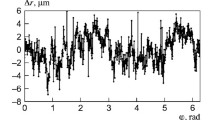Abstract
The form error in manufactured parts needs to be assessed to verify the compliance of the parts with the specifications. Workpieces are usually measured by means of a coordinate measuring machine that extracts a set of three-dimensional points from the manufactured surface. It is obvious that the association method used to fit the nominal shape to the set of points plays an essential role in the error assessment process. Moreover, the uncertainty that arises during the measurement procedure must be estimated to provide a complete measurement result. Within this framework, the aim of this paper is to compare the performances of the so-called probabilistic method with those of the classical least squares methods in order to estimate different roundness errors together with the associated uncertainty. The latter has been estimated by means of two different approaches: the bootstrap and the so-called gradient-based method, and the differences between the two are discussed.
Similar content being viewed by others
References
Ahn SJ, Rauh W, Warnecke H-J (2001) Least-squares orthogonal distances fitting of circle, sphere, ellipse, hyperbola, and parabola. Pattern Recogn 34(12):2283–2303
Capello E, Semeraro Q (1999) The effect of sampling in circular substitute geometries evaluation. Int J Mach Tools Manuf 39(1):55–85
Chiabert P, Costa M (2002) Probabilistic description of mechanical surfaces. In: Proceedings of 3rd CIRP international seminar on intelligent computation in manufacturing engineering, pages 479–484, Ischia, Italy
Chiabert P, Costa M, Pasero E (2001) Detection of continuous symmetries in 3D objects from sparse measurements through probabilistic neural networks. In: IEEE International Workshop on Virtual and Intelligent Measurement Systems (VIMS, 2001), pp 104–110
Chiabert P, De Maddis M, Gandini M (2009) Discrimination of hidden information in measurement results, management of technology. In: Step to Sustainable Production-MOTSP2009, Sibenik, Croatia, pp. 10–12
Chiabert P, De Maddis M, Ruffa S (2006) A unifying statistical approach for the recognition of invariant product shapes. In: Proceedings of ICAD2006 Fourth International Conference on Axiomatic Design. Firenze (Italy)
Chiabert P, De Maddis M, Ruffa S (2007) Research on feature partitioning: analysis of efficiency and reliability of ISO algorithms. In: Proceedings of the 8th A.I.Te.M. Conference. Montecatini Terme, Italy
Chiabert P, Ruffa S (2008) Shape partitioning based on symmetries detection. International Journal of Shape Modeling 25:79–104
Chiabert P, Costa M (2003) Statistical modelling of nominal and measured mechanical surfaces. J Comput Inf Sci Eng 3:87–94
Costa M, Chiabert P (2001) Probabilistic evaluation of invariant surfaces through the Parzen’s method. In: Proceedings of the 7th CIRP International Seminar on Computer Aided Tolerancing. Ens de Cachan, France
Cui C, Shiwei F, Huang F (2009) Research on the uncertainties from different form error evaluation methods by CMM sampling. Int J Adv Manuf Technol 43(1-2):136–145
Dantan J-Y, Ballu A, Mathieu L (2008) Geometrical product specifications—model for product life cycle. Computer-Aided Design 40(4):493–501
De Maddis M, Gandini M, Ricci F, Ruffa S (2010) Analysis of influence of verification strategy on roundness error evaluation. In: 7-th CIRP ICME Conference, Capri, p 4
Desta MT, Feng H-Y, OuYang D (2003) Characterization of general systematic form errors for circular features. Int J Mach Tools Manuf 43(11):1069–1078
Efron B (1979) Bootstrap methods: another look at the jackknife. Ann Stat 7(1):1–26
Gosavi Abhijit, Cudney E (2012) Form errors in precision metrology: a survey of measurement techniques. Qual Eng 24(3):369–380
GUM (2008) Evaluation of measurement data—guide to the expression of uncertainty in measurement. JCGM 100
ISO (1995) Geometrical product specification (GPS)—masterplan. ISO/DTR 14638
ISO/TS, Geometrical product specifications (GPS)—general concepts—part 2: basic tenets specifications operators and uncertainties. 17450-2:2002
Miura K (2011) An introduction to maximum likelihood estimation and information geometry. Interdiscip Inf Sci 17(3):155–174
Parzen E (1962) On estimation of a probability density function and mode. Ann Math Stat 33(3):1065–1076
Ruffa S, Panciani GD, Ricci F, Vicario G (2013) Assessing measurement uncertainty in CMM measurements: comparison of different approaches. International Journal of Metrology and Quality Engineering 4:163–168
Srinivasan V (1999) A geometrical product specification language based on a classification of symmetry groups. Comput Aided Des 31(11):659–668
Venkaiah N, Shunmugam MS (2007) Evaluation of form data using computational geometric techniques—part I: circularity error. Int J Mach Tools Manuf 47(7–8):1229–1236
Vosselman G, Haralick RM (1996) Performance analysis of line and circle fitting in digital images. In: Workshop on Performance Characteristics of Vision Algorithms
Yusupov J (2015) On the assessment of the form error using probabilistic approach based on symmetry classes. PhD thesis, Politecnico di Torino, Turin
Author information
Authors and Affiliations
Corresponding author
Rights and permissions
About this article
Cite this article
Chiabert, P., De Maddis, M., Ruffa, S. et al. Probabilistic method in form error evaluation: comparison of different approaches. Int J Adv Manuf Technol 92, 447–458 (2017). https://doi.org/10.1007/s00170-017-0144-1
Received:
Accepted:
Published:
Issue Date:
DOI: https://doi.org/10.1007/s00170-017-0144-1




